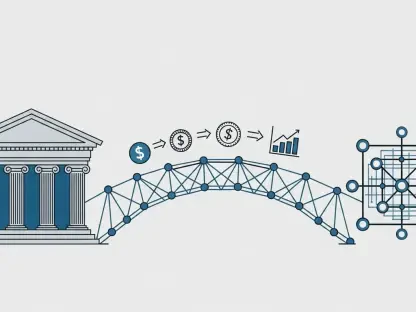In a remarkable shift within the financial sector, traditional banks have poured over $100 billion into blockchain infrastructure since 2020, marking a transformative pivot toward decentralized technologies that promise to redefine the industry. This staggering investment reflects a growing recognition among financial institutions that blockchain is no longer just a speculative trend but a foundational tool for modernizing operations. From enhancing cross-border payments to tokenizing real-world assets, banks are strategically channeling funds into practical applications that address inefficiencies and unlock new opportunities. Backed by comprehensive data from thousands of investment deals and surveys of financial executives, this surge signals a consensus that blockchain will play a pivotal role in the future of finance. As institutions navigate regulatory complexities and market volatility, their commitment to integrating this technology remains steadfast, setting the stage for a deeper exploration of how these investments are being deployed.
Strategic Focus on Blockchain Infrastructure
The core of banking investments in blockchain centers on building robust infrastructure to support critical financial functions, with over a quarter of the $100 billion directed toward settlement systems and asset issuance platforms. This focus underscores a deliberate move away from mere cryptocurrency speculation toward creating scalable solutions that can handle high-volume transactions with greater speed and lower costs. Cross-border payments, long plagued by delays and high fees, are a primary target, as blockchain offers near-instantaneous transfers that bypass traditional intermediaries. Major institutions like HSBC, with its tokenized gold platform, exemplify this trend by leveraging blockchain to create secure, transparent systems for asset management. This infrastructure investment is not just about technology adoption but about reimagining how financial services can operate in a digital-first world, prioritizing efficiency and accessibility for both banks and their clients.
Beyond settlement and issuance, a significant portion of blockchain investment is fueling the development of custody solutions, with nearly two-thirds of surveyed bank executives actively exploring this area. Custody services are essential for securely storing digital assets, a growing need as more institutions and individuals engage with cryptocurrencies and tokenized assets. The emphasis here is on building trust through robust security protocols that protect against cyber threats and ensure regulatory compliance. Banks are partnering with technology providers to develop these solutions, recognizing that safe storage is a cornerstone of mainstream blockchain adoption. This strategic allocation of resources also extends to stablecoins, which offer price stability compared to volatile cryptocurrencies, making them a practical tool for transactions and reserves. By investing in custody and stablecoin infrastructure, banks are positioning themselves as leaders in a rapidly evolving digital asset landscape, ready to meet emerging demands.
Collaboration and Innovation with Fintech Partners
A defining feature of the blockchain investment boom is the deepening collaboration between traditional banks and fintech firms, creating a synergy that accelerates innovation. Financial giants such as Citigroup and Goldman Sachs are not only funding blockchain startups but also integrating fintech solutions into their operations, as seen with platforms like Goldman Sachs’ GS DAP for digital asset issuance. These partnerships allow banks to tap into cutting-edge expertise while fintechs gain access to vast resources and established customer bases. This collaborative model is evident in initiatives aimed at making digital assets more accessible, breaking down barriers that once limited blockchain to niche markets. By working together, these entities are forging a path toward mainstream adoption, ensuring that blockchain technology becomes a seamless part of everyday financial services rather than a standalone novelty.
Another dimension of this collaboration is the focus on tokenization, where real-world assets like real estate or bonds are converted into digital tokens on a blockchain for easier trading and ownership. Over half of the surveyed financial institutions are investing in tokenized assets, viewing them as a way to democratize access to investments and enhance liquidity. This trend is no longer theoretical but is being actively implemented, with banks launching pilot programs to test tokenized bonds and other instruments. The partnership model proves vital here, as fintechs often provide the technical know-how to execute complex tokenization processes, while banks offer the regulatory credibility and market reach needed for scale. This joint effort highlights a shared vision for a future where blockchain underpins a more inclusive and efficient financial ecosystem, reshaping how value is created and transferred globally.
Global Momentum and Future Outlook
Despite regulatory uncertainties and past market disruptions like high-profile crypto exchange failures, blockchain investment by banks has shown remarkable resilience, peaking in early 2024. Emerging markets such as the UAE, India, and Singapore have become significant contributors to this growth, reflecting a global shift toward embracing decentralized technologies. These regions are increasingly seen as innovation hubs, where favorable policies and a hunger for financial modernization drive blockchain adoption. Banks in these areas are not just following trends but are actively shaping them, investing in solutions tailored to local needs, such as remittances and microfinance. This global momentum underscores a broader understanding that blockchain is not a threat to traditional finance but a complementary tool that can streamline operations and expand access to services across diverse economies.
Looking ahead, the commitment to blockchain remains strong, with an overwhelming 90% of financial leaders believing cryptocurrencies will profoundly influence finance by 2028. Half of the institutions surveyed plan to roll out tokenized bond pilots or develop settlement layers for central bank digital currencies (CBDCs) and stablecoins within the next three years, from 2025 to 2028. This forward-thinking approach indicates a long-term strategy to integrate blockchain into core financial systems, rather than treating it as a peripheral experiment. The persistent challenges of regulatory frameworks in certain regions have not deterred this progress; instead, they have prompted banks to advocate for clearer guidelines while continuing to innovate. As investments continue to flow, the focus on practical applications ensures that blockchain’s potential is harnessed responsibly, paving the way for a financial landscape that is more efficient, transparent, and inclusive.
Reflecting on a Transformative Journey
Reflecting on the past few years, traditional banks have demonstrated unwavering determination by investing over $100 billion in blockchain infrastructure since 2020, fundamentally altering the trajectory of financial services. This period saw a shift from skepticism to strategic adoption, as institutions embraced decentralized technologies to address longstanding inefficiencies. Collaborations with fintechs flourished, tokenization became a reality, and global markets united in their push for innovation, even amidst regulatory and market challenges. Looking back, the journey revealed a collective belief in blockchain’s capacity to modernize finance, evidenced by tangible projects and a consensus among leaders about its future impact. Moving forward, banks must continue to prioritize scalable solutions, advocate for balanced regulations, and invest in education to ensure stakeholders understand blockchain’s benefits. By building on these foundations, the financial sector can fully realize the promise of a decentralized future, transforming challenges into opportunities for growth.









